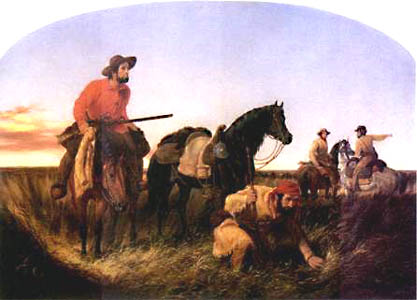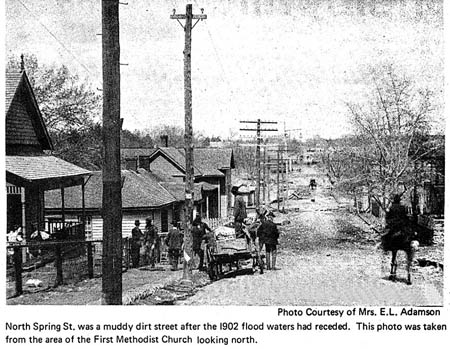 |
|
 |
|
Compiled by the Rev. John P. Campbell
Originally published by Smith, Camp & Co., 16 Deaderick St.,
Nashville
reprinted for Century III Nashville, c1980
Index to Written on Many Hearts, the history of the Presbyterian Church in Shelbyville, TN.
Indexes by Lucy Bryant Dunaway Zeier. Please report any errors to Lucy (tnconnections@comcast.net).
Hutson, J. L., Old times in Bedford County, Tenn., [197-?]
History of Rover and the 10th district of Bedford County, c 1986.
Doors to the past : homes of Shelbyville and Bedford County, c 1969.
Ferguson, Roy Sonny., Who, when, and what : Bedford County, [199-?]
Cook, Jerry Wayne, Historic Normandy, Bedford County, Tennessee, 1976.
Jacobs, Lucile Frizzell, Duck River Valley in Tennessee and its pioneers, 1968.
Weyss, J. E, Sketch of the environs of Shelbyville, Wartrace & Normandy, Tennessee, 1863.
The Goodspeed histories of Maury, Williamson, Rutherford, Wilson, Bedford and Marshall Counties of Tennessee, 1971.
Centennial celebration, 4th of July, 1876, at Shelbyville, Bedford County, Tennessee. Embracing opening address of Hon. Thos. H. Coldwell, president of the day. Address of Hon. Edmund Cooper. ..., 1877.
History of Tennessee : from the earliest time to the present; together with an historical and a biographical sketch of Maury, Williamson, Rutherford, Wilson, Bedford and Marshall counties, 1886.
During the history of Shelbyville and Bedford County floods have left their mark on the landscape. The most severe floods occurred in 1902, 1929, and 1948.
The March 1902 flood was the greatest known on the Duck River at Shelbyville. It reached an elevation of 737.4 above sea level at the dam, where flood stage Is 719 feet. A description in the April 3, 1902, Shelbyville Gazette stated that "In the course of time Shelbyville and Bedford County have suffered from heavy freshnets, but within the memory of our oldest inhabitants none of them equaled in magnitude or extent of damage done the one we had last week."
"It began to rain here heavily on Thursday night and on Friday we had a downpour all day long. It did not fall in drops but in great sheets. As a consequence, Duck River rose rapidly all day and soon after dark on Friday it was far beyond its banks on either side, and its backwater soon covered all the residence section known as the ''Big Spring" part of town. It entered residence after residence, and homes never before reached by water were soon submerged, many of them up to the second story. Taken suddenly and by surprise, as it were, many families were rescued by boats. Some houses were washed entirely away and others were twisted on their foundations. The high water extended east of the Murfreesboro Pike and entered residences considered hitherto beyond all high water marks. Hence many residences fronting on the pike and streets west of it were much damaged, and families put to great inconvenience. To mention each house would require more space than we can spare, but we are assured that there are as many as 116 of them. But all of them were in the limit of the town. The pencil factory with all of its machinery and a large amount of pencil timber, was swept away. The fine steel bridge across Duck River at this place was swept away on Friday night. Many of the streets were covered with water deep enough to float the largest steamboat, and especially was this so with the streets leading to and from the western part of town. The trains ran only to Wartrace; there were no malls, no telegraph communications, and the only communication was an imperfect one by telephone.
"The Shelbyville Cotton Mills, on the river one mile below town, were heavily damaged and several of the residences occupied by the operatives of the factory were swept away and the people lost heavily ln the way of goods, clothing and furniture.
"The crest of the flood occurred at 4:00 a.m. on March 29. The damages were estimated at a loss of $150,000 in Shelbyville and $200,000 in the county. All but one of the steel bridges erected by the county were washed away."
The March 1929 flood was the second highest in the history of Shelbyville. The crest in Shelbyville March 23 was 735.2 feet, approximately 2.2 feet under that of March 1902, according to high water profiles for the two floods.
The following description was given in the March 28, 1929, Gazette. "The flood in Duck River on last Saturday and Sunday was nearly as high as it was on March 28, 1902.
"As early as three o'clock Saturday morning some of the houses near the Big Spring Branch were flooded and the inhabitants were compelled to move out. Some of them were entirely surrounded by the back waters from the river before they realized what was happening.
"Mrs. Couch gave the first alarm by firing a heavy calibre pistol. And thus Mrs. Couch spread the alarm of the fast rising waters that would in all probability have resulted [in?] fatal[ity?] to scores of human beings. The work of rescue started in the danger zone.
"The river continued to rise all day Saturday until six o'clock in the afternoon. The water inundated residence after residence. [It?] was worse in the part of town along "Big spring Branch" and some of them were submerged entirely, outhouses and garages being washed away. The work of rescuing the sufferers went on until all were - safe and [?] household goods were [?] from residences being threatened and afterwards nearly submerged. The waters rose so rapidly that much of the household goods could not be moved. [?] water extended east to Main Street, where it was some six feet deep in the buildings in vicinity of Hoover's Garage.
[?] W. H. Gosling's store. The bridge recently built at this [?] was entirely covered up [?] several feet.
"There were as many as 102 homes submerged by flood waters. All of these were in the town limits.
"Directly across the river three residences were washed away. There were many other residences across the river flooded by the high waters, but there was no loss of life anywhere.
"A great deal of damage was done at Shelbyville Mills, two miles below town, and five or six cottages were washed away. In some of these, household articles went with the raging waters. Many other houses were dislodged from their foundations, and the high waters entered many more."
The February 1948 flood was the third highest known in Shelbyville. The flood waters began entering the low area of Shelbyville during the evening of February 12. Soon after dark, volunteer workers and trucks began evacuating endangered families. A total of 151 families and their belongings were taken to safety during the night and the early morning of Friday, February 13.
Announcements over the radio instructed people to fill receptacles with water before the pumping station was submerged, thus permitting the city to survive a 24-hour shutdown of the pumps.
The river reached its crest of 734.6 in town soon after 3:00 p.m. on February 13, and four hours later began receding. However, much of the town was still under water on the afternoon of February 14. Some business concerns in the flooded area were back in operation by February 16 and by February 20 nearly all businesses were functioning and over half of the flooded homes were occupied again.
At the crest, the flood waters covered portions of fifteen streets in the downtown section. The river bridge was submerged to the top of the handrails, and Cannon Boulevard was under water for 1,000 feet south of the bridge. Within the city limits, 129 houses were flooded to depths varying from a few inches to nearly complete submergence.
About 25 others were surrounded by water. Two houses on the south side of West Lane Street were floated off their foundations. Ten houses located just east of the city limits were flooded.
Sixty-three business places were covered to depths ranging from a few feet to over 10 feet. Many of these business places were located along North Main and North Spring Streets where flood depths were near a maximum. No industries were affected in Shelbyville, but Shelbyville Mills U. S. Rubber Company's tire fabric plant was forced to shut down for three days when water in varying depths flooded the boiler room, machine shop, compressor room, the main floor and basement of the cotton storage warehouse, and the laboratory in the basement of the main plant.


Return to Bedford County TN Gen Main Page
